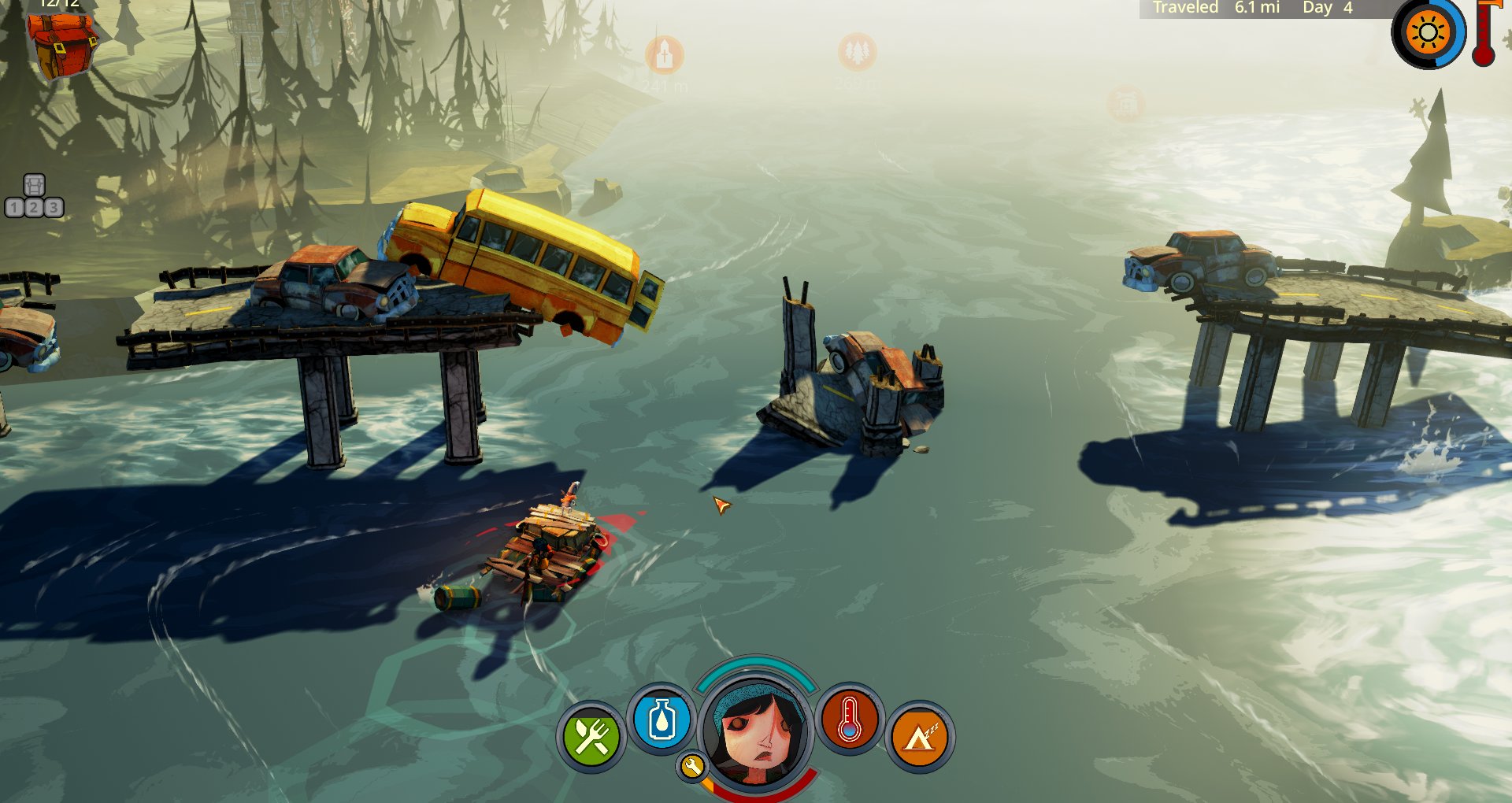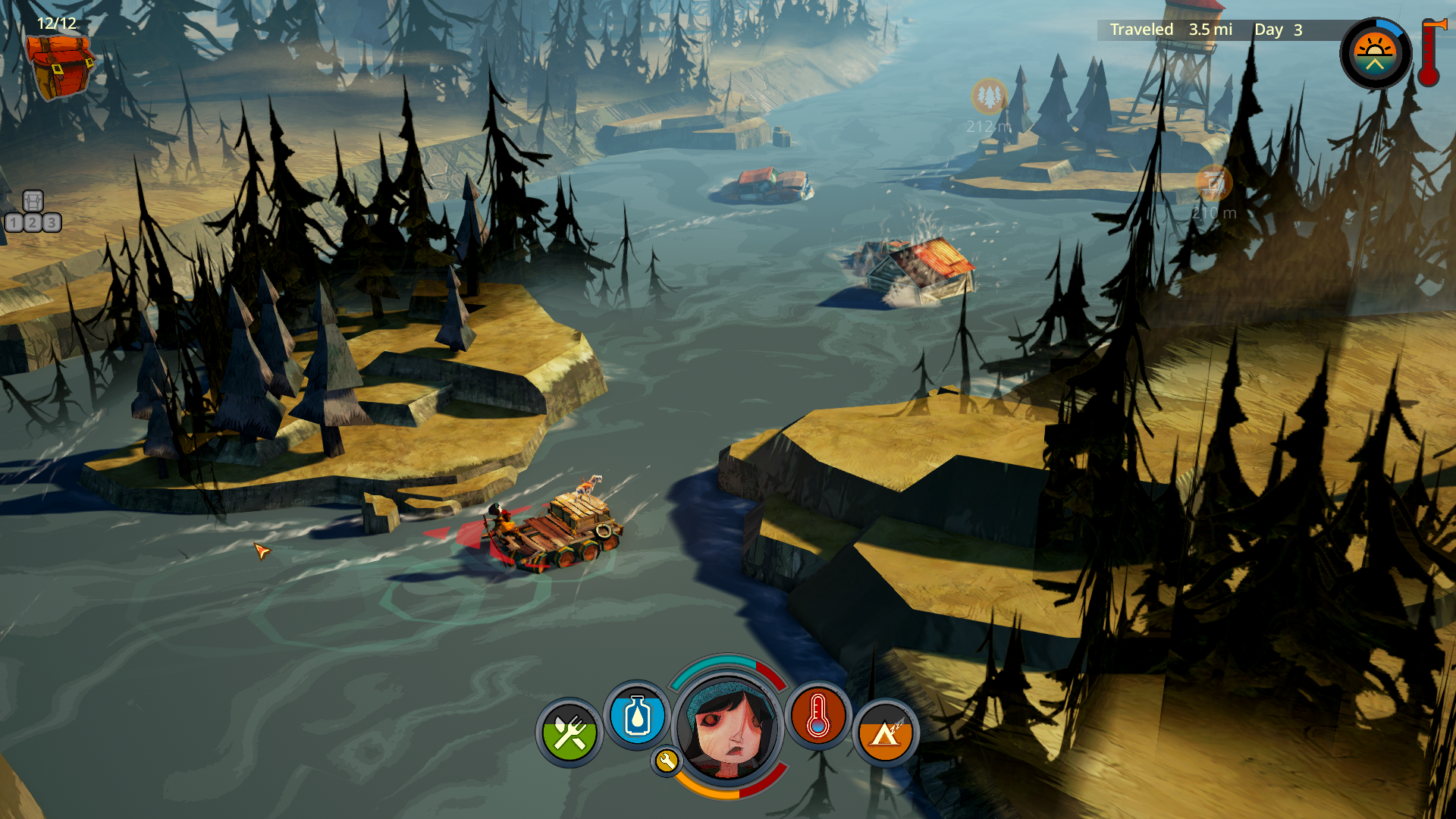Our Verdict
Lovely and challenging with enjoyable crafting and survival elements, but poor river controls make it harsher than it should be.
PC Gamer's got your back
What is it? A survival roguelike where you travel down a river scrounging for supplies.
Expect to pay: $20/£16
Developer: The Molasses Flood
Publisher: The Molasses Flood
Reviewed on: Intel i7 x980 3.33 GHz, 9 GB RAM, Nvidia GeForce GTX 960
Multiplayer: No
Link: Official Site
The spear trap, given to me by a couple of helpful feral children, works perfectly, impaling the lunging wolf just as it's about to tear me to ribbons. I prepare to disassemble the carcass, gleefully—wolves have been a frequent cause of death in games past—when two more wolves suddenly appear. It’s about the most fleeting victory in video games history, I wind up torn to ribbons yet again, and my dreams of spitefully dining on delicious wolf jerky go unfulfilled.
In The Flame in the Flood, a roguelike survival game by developer The Molasses Flood, you play as Scout, a little girl riding a raft down a swollen, raging river during a soggy post-apocalypse. You dock periodically at randomly generated campsites and clearings to scavenge for supplies, craft gear, and try to keep yourself fed, hydrated, and warm. The dangers are many: starvation, dehydration, injuries, wild animals, and disease. The river itself, filled with jagged rocks, uprooted trees, rusting autos, and slowly drowning houses, is both your only chance for survival and the greatest threat to it.
Sticks and stones
At times The Flame in the Flood is a wonderfully serene experience, such as when paddling down the moonlit river—the calmer portions of it, anyway—accompanied by a sleepy, twangy soundtrack, or when sitting by a crackling campfire to cook corn muffins or brew dandelion tea, faithful dog Aesop by your side. It can quickly plunge into delicious, panicky chaos as well, such as when a storm suddenly rolls in, dousing your fire and forcing you to seek shelter and warmth, or when a single encounter with a wild animal leaves you bleeding, near death, and limping back to your raft on broken bones.

Crafting is simple and pleasurable. You have a recipe list, and the items you can currently make are bumped to the top of the menu. You can craft snares to catch small animals, traps to kill bigger ones, clothing to keep you warm and dry, and upgrades for your raft. Ingredients can be eaten raw, though for less nourishment and more risk than cooking—some have poisonous side-effects. Clean water can be found at pumps, or you can craft a filter that allows you to strain bacteria out of puddles. Hunger and thirst are pressing needs, but unlike a lot of survival games they’re well balanced here, and I never felt like too much of my scavenging time was taken up by hunting for nourishment.

I’m of two minds about the river itself, though. I love the idea of it as an unstoppable force, propelling you through the game in one direction. If you’re swept past a campsite, you’ve got no choice but to keep going. If a clearing is full of wolves or boars or snakes and you’ve got no way to defend yourself, you have to simply flee, leaving unlooted crates and life-saving supplies behind forever. The words “Do not idle” are painted on a sign at the start of the game, and the river gives you no choice but to heed them.
Practically, though, I despise the river, specifically the rapids sections. I don’t expect controlling a ramshackle raft in a churning flood to be easy, but it’s hard mainly for the wrong reasons: the controls are sloppy and unwieldy. The mouse or WASD lets you choose a direction, and the space bar gives you a lurching boost that may take you through the gap you’re aiming for, or may cause you to overshoot and slam against a rock, or may barely move you at all. Dying from a boat crash can be frustrating when you’re otherwise well-supplied and healthy, and it’s somehow even worse when you’re near death in the first place. Clawing your way back from the brink of disaster is the most satisfying experience survival games have to offer, but here it’s undercut by an unforgiving river that far too often never gives you the chance.
Camp pain
There are two ways to play The Flame in the Flood. There’s endless mode, where the river is eternal, death is permanent, and you try to get as far as you can each time you play. There’s also a campaign mode where you’re tasked with surviving through 10 different regions. Campaign has two difficulty levels, the easier of which gives you the ability to reload your game from checkpoints.These two modes, however, share a single save file so you can’t have a game of endless and a campaign going at the same time, which seems silly.

Despite graduating from Early Access, The Flame in the Flood could still use a bit more bug-squashing. From time to time you’ll come across a quilt that, when examined, gives you a little bit of story. It also freezes my game. It’s not a fluke, either: in every game I played where I found and examined that quilt it locked me up, forcing a manual restart. Another annoyance: the dog barks helpfully when he’s found something of use, but he also barks at supply caches I’ve already emptied, often making me check them again for no purpose. I’ve also repeatedly run into a bug where all sound effects completely stop playing (on the plus side, it shut the dog up).
Bugs aside, I enjoyed a great deal of The Flame in the Flood. It’s full of beautiful art and sound design, the survival is fun and challenging, and the world is both somber and colorful. I only wish the rafting controls were better. When wolves slaughter me, I blame myself for not being careful enough, but no amount of caution on the river seems to save me.
Lovely and challenging with enjoyable crafting and survival elements, but poor river controls make it harsher than it should be.

Chris started playing PC games in the 1980s, started writing about them in the early 2000s, and (finally) started getting paid to write about them in the late 2000s. Following a few years as a regular freelancer, PC Gamer hired him in 2014, probably so he'd stop emailing them asking for more work. Chris has a love-hate relationship with survival games and an unhealthy fascination with the inner lives of NPCs. He's also a fan of offbeat simulation games, mods, and ignoring storylines in RPGs so he can make up his own.


